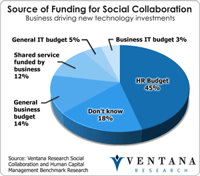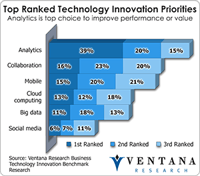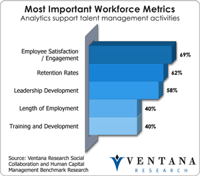ESG reporting is a matter that organizations – and especially publicly held corporations – will be confronting over the next several years. Ventana Research asserts that by 2025, one-half of corporations with 1,000 or more employees will have a formal ESG reporting process in place to address legal mandates or shareholder demand. The roots of ESG investing go back many decades but it has gained significant attention recently as demand in the investment world for non-accounting measures to guide...
Read More
Topics:
FP&A,
Governance,
Office of Finance,
Performance,
Reporting,
CFO,
ESG
Maximizing the performance and value of people in the workforce should be a primary focus for any business these days. It is a complex task, especially for larger organizations, and chances for success can be increased by investment in human capital management (HCM) applications. In this competitive software market SAP is making a strong push, aided by acquisitions in the last three years of SuccessFactors for talent management and more recently Fieldglass for contingent labor management....
Read More
Topics:
SAP,
HCM,
Human Capital Management,
Learning,
Performance,
Recruiting,
SuccessFactors,
Operational Performance,
Analytics,
Business Analytics,
Business Performance,
Cloud Computing,
Financial Performance,
Compensation,
HRMS,
Vendor Management Systems,
Workforce Analytics,
Workforce Management,
Workforce Planning
The developed world has an embarrassment of riches when it comes to information technology. Individuals walk around with far more computing power and data storage in their pockets than was required to send men to the moon. People routinely hold on their laps what would have been considered a supercomputer a generation ago. There is a wealth of information available on the Web. And the costs of these information assets are a tiny fraction of what they were decades ago. Consumer products have...
Read More
Topics:
Big Data,
Mobile,
Predictive Analytics,
Sales Performance,
Social Media,
Customer Experience,
Performance,
Operational Performance,
Analytics,
Business Analytics,
Business Collaboration,
Business Intelligence,
Business Performance,
Customer & Contact Center,
Financial Performance,
IBM,
finance,
Sales Performance Management,
Social,
Financial Performance Management,
SPSS
Improving how employees and managers can improve talent management activities through changes in process, technology and better access to information is both a theme of my research agenda this year. It is also what the key technology vendors in this space have been focused on developing products to do. Cornerstone OnDemand is one of those vendors that has been in the talent management space since 1999, when it launched its original CyberU learning management product, and now offers a broad...
Read More
Topics:
Sales Performance,
Salesforce.com,
Social Media,
HCM,
Learning,
Performance,
Recruiting,
Business Collaboration,
Business Performance,
Cloud Computing,
Workforce Performance,
Cornerstone OnDemand,
HR
Read More
Topics:
Sales Performance,
Social Media,
Supply Chain Performance,
Human Capital Management,
Kenexa,
Learning,
Performance,
Recruiting,
Smarter Analytics,
Smarter Workforce,
Social Business,
Social Collaboration,
Operational Performance,
Business Analytics,
Business Collaboration,
Business Intelligence,
Business Performance,
Cloud Computing,
Customer & Contact Center,
Financial Performance,
IBM,
Workforce Performance,
Compensation
I attended SuccessConnect (Twitter: #sconnect), the annual SuccessFactors conference, to hear the latest from this talent management applications company. A lot has changed for the formerly independent company since it acquired Plateau less than a year ago and Jobs2Web. In turn, earlier this year SAP acquired SuccessFactors to expand its cloud computing business. Its recently outlined expansion as part of SAP’s overall cloud computing strategy is beginning to take shape.
Read More
Topics:
Sales Performance,
Social Media,
Supply Chain Performance,
HCM,
Human Capital Management,
Performance,
Recruiting,
Operational Performance,
Business Analytics,
Business Collaboration,
Business Performance,
Cloud Computing,
Customer & Contact Center,
Financial Performance,
Workforce Performance,
HR
Acquisitions and new product releases continue to make the market for human capital management a hotbed of activity, as organizations attempt to fully utilize and increase the value of their workforces as I have outlined in my research agenda. ADP, with more than $10 billion in revenues and more than 570,000 customers, is aiming for the top spot in this market.
Read More
Topics:
Mobile,
Social Media,
HCM,
Human Capital Management,
Learning,
LMS,
Performance,
Operational Performance,
Business Analytics,
Business Performance,
Cloud Computing,
Financial Performance,
Workforce Performance,
Compensation,
HR,
TCM
This week Peoplefluent announced that it has invested in Socialtext, a company that provides social collaboration software at the enterprise level. With this strategic investment Bedford Funding, the private equity firm that owns Peoplefluent, is the direct beneficiary. Peoplefluent will extend Socialtext into the human capital management market while continuing to let the company meet the broader market interest in its offering. Peoplefluent has moved quickly to make this application and...
Read More
Topics:
Sales Performance,
Social Media,
Sustainability,
Human Capital Management,
LMS,
Peoplefluent,
Performance,
Recruiting,
Research,
SocialText,
Business Analytics,
Business Collaboration,
Business Mobility,
Business Performance,
Cloud Computing,
Financial Performance,
Governance, Risk & Compliance (GRC),
Information Applications,
Information Management,
Mobility,
Workforce Performance,
Compensation,
HR,
HRMS,
Talent Management,
Workforce Analytics
Competition in the human capital management market rages on, with application suppliers racing to provide sophisticated applications that operate in the cloud. Cloud computing is a key factor in advancing human capital management, included in our research agenda for this area, along with analytics, collaboration, mobility and social media.
Read More
Topics:
Sales Performance,
SAP,
Social Media,
Sustainability,
Human Capital Management,
LMS,
Performance,
Recruiting,
Research,
Business Analytics,
Business Collaboration,
Business Mobility,
Business Performance,
Cloud Computing,
Financial Performance,
Governance, Risk & Compliance (GRC),
Information Applications,
Information Management,
Mobility,
Oracle,
Workforce Performance,
Compensation,
HR,
HRMS,
Talent Management,
Workday,
Workforce Analytics
The workforce analytics market continues to evolve as organizations seek to improve the time it takes to find insights and employer metrics in order to meet compliance requirements, mitigate risk and enforce governance policies. TALX, a subsidiary of Equifax, provides a range of data-oriented services that help HR, payroll and tax professionals. Its integration with eVerify service assists the hiring process with I-9 compliance, and capabilities to examine workforce compensation and financial...
Read More
Topics:
Sales Performance,
Social Media,
Sustainability,
eThority,
Human Capital Management,
LMS,
Performance,
Recruiting,
Research,
Business Analytics,
Business Collaboration,
Business Mobility,
Business Performance,
Cloud Computing,
Financial Performance,
Governance, Risk & Compliance (GRC),
Information Applications,
Information Management,
Mobility,
Workforce Performance,
Compensation,
HR,
HRMS,
Talent Management,
TALX,
Workforce Analytics















